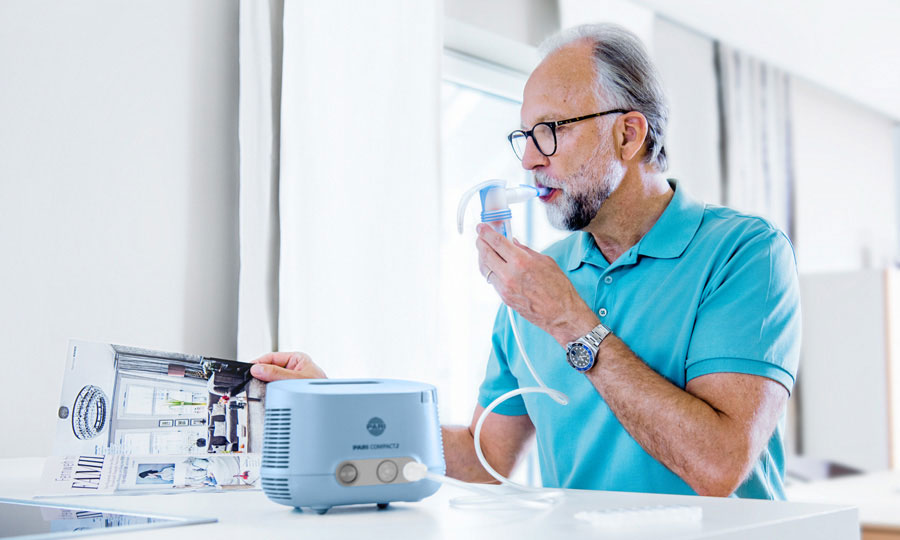COPD stands for Chronic Obstructive Pulmonary Disease. As the name suggests, people suffering from COPD often have constricted (obstructed) bronchi and/or mucus build-up in their lungs. Lung emphysema can also occur, which leads to the alveoli (air sacs) being destroyed. Typical COPD symptoms are shortness of breath, chronic coughing, sputum production and recurrent airway infections.
Comprehensive treatment and care of the airways are particularly important in COPD. Nebuliser treatment is an effective way of doing this. Here you can learn what to look for in a nebuliser for COPD and how to use it correctly.
Nebulisers for COPD create a fine mist that can be inhaled via a mouthpiece or a mask, by breathing naturally. When doing so, the fine mist reaches the lungs, and the medication or saline solution can have its intended effect. This effect depends on the treatment goal.
Bronchodilators are nebulised to widen the obstructive airways. Isotonic saline solutions moisten the airways. This supports our first line of defense of the lungs against infections. Hypertonic saline can be inhaled to help loosen the thick mucus and thus ease breathing. Mucus clearance is an important treatment goal in COPD.
The use of a nebuliser for the treatment of COPD presents several benefits. Primarily, nebulisers convert liquid medication into a fine mist, enabling deeper penetration into the lungs. This allows for the medication to act directly at the site of inflammation and constriction, offering rapid symptom relief.
Additionally, nebulisers are beneficial for patients who may have difficulty using handheld inhalers due to severe respiratory distress or coordination challenges. The ease of use encourages patients to stick to their treatment routine and therefore treatment outcomes benefit. Nebulisers also allow for a combination of medications to be administered at the same time, which can simplify complex medication plans.
Pros of Nebulisers for COPD
Cons of Nebulisers for COPD
Pros of Inhalers for COPD
Cons of Inhalers for COPD
What is most important when comparing nebuliser vs inhaler for COPD is the patient. Inhaler mishandling is very common amongst patients with severe COPD flare ups 3. GOLD 2024 recommends considering nebulisers if other inhalers have not worked with a patient 4. A study also showed that patients and their caregivers preferred nebulisers over other devices due to ease of use, better overall symptom control and long-term relief 5.

In cases where nebuliser therapy is advisable, the NICE Guidelines (2019) for the diagnosis and treatment of COPD recommend using a nebuliser that is known to be efficient. Efficiency can objectively be measured by the RDDR (Respirable Drug Delivery Rate). A publication points out that there are major differences between nebuliser systems in terms of efficiency [6]. PARI nebulisers show outstanding performance in terms of RDDR.
Select a nebuliser from a trustworthy manufacturer that ensures strict quality standards for your health. There are differences in performance which may reflect the product's price. Therefore, going for the cheapest option might not be the best choice.
References
[1] Dhand et al. (2012), COPD. 9(1), https://pubmed.ncbi.nlm.nih.gov/22292598/
[2] Loh et al. (2017) Ann Am Thorac Soc 14(8), https://pubmed.ncbi.nlm.nih.gov/28406710/
[3] Molimard et al. (2017), Eur Respir J (https://pubmed.ncbi.nlm.nih.gov/28182569/)
[4] GOLD 2024
[5] Dumra et al. International Journal of Chronic Obstructive Pulmonary Disease 2022:17;2277-2288. (https://pubmed.ncbi.nlm.nih.gov/36133736/)
[6] Fischer et al., 2022.
Contact us
Any questions? You can reach us at this number:
01932 341122
© 2025 PARI GmbH Spezialisten für effektive Inhalation